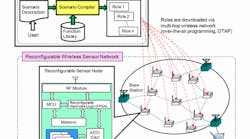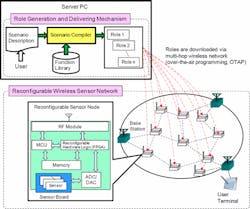The clear advantages brought by wireless sensor networks (WSNs) for environmental observation or security systems are increasing the focus on these node-based sensor platforms. Because it is difficult to adapt the behavior of WSNs after they have been deployed, researchers are now looking to develop software-defined WSNs (SDWSNs). Such networks hold the promise of rapid customization and adaptability. In hopes of bringing these networks to fruition, a group of researchers has teamed, thanks to support from Japan’s Strategic Information and Communication R&D Promotion Program and Grants-in-Aid for Scientific Research. These researchers include Toshiaki Miyazaki, Shoichi Yamaguchi, Koji Kobayashi, Junji Kitamichi, Song Guo, Tsuneo Tsukahara, and Takafumi Hayashi.
To control the behavior of the SDWSN, the team uses wireless communications to assign roles to the individual sensor nodes. This requires a role generation and delivery mechanism as well as a reconfigurable sensor node. Each sensor node is equipped with a microprocessor unit (MCU) for general program tasks and a field-programmable gate array (FPGA) to handle sensor and data processing efficiently.
The role generator is composed of a scenario compiler that generates roles based upon the scenario description, which specifies the behavior of the sensor nodes. These roles are transmitted wirelessly and downloaded using a multi-hop wireless network. A base station and control terminal are required to operate the role generator. The delivery mechanism relies on a wireless-network access point powered by a 920-MHz RF module.
Power consumption of the sensor node was measured at 220 mW with the majority of power consumed by the RF module. Using a 32-bit central processing unit (CPU) instead of the MCU, the power consumption increased to 899 mW. The CPU version could run up to 20 hours using a 10,000-mAh battery. In contrast, the MCU version could potentially run for more than 80 hours at a rate of 25 packets per second. See “A Software Defined Wireless Sensor Network,” 2014 International Conference on Computing, Networking, and Communications (ICNC), Feb. 2014, pp. 847-852.

